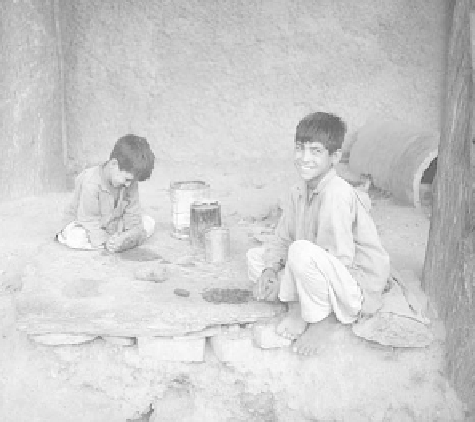Geography Reference
In-Depth Information
beset with political violence in recent years. Bhutan is
trying to maintain its traditional culture in the face of
globalization and modernization.
The Himalayas extend across eight nations:
Afghanistan, Pakistan, India, China, Nepal, Bhutan,
Bangladesh, and Myanmar. The relative isolation pro-
moted by the world' s highest peaks and deepest gorges
has sustained both natural and human diversity among
the 120 million who live here. Many people speak Sino-
Tibetan languages and practice Tantric or V ajrayana Bud-
dhism Figure 6-11).
The critical positioning of these various peoples be-
tween the political giants of India and China has deeply
affected their ways of life and threatened or even elimi-
nated their autonomy . Only Nepal and Bhutan remain in-
dependent states in the Himalaya. Ladakh and Sikkim,
once independent, are now part of India. Border conflicts
and unstable political boundaries are facts of shatter-
zone existence.
Figure 7-13
In Saidu Sharif, these boys are rolling balls of opium to be sold in
local shops for processing elsewhere. Drugs are an important
source of income for militants such as the T Taliban.
Photograph courtesy of B. A. Weightman.
NEPAL: A KINGDOM NO MORE
Landlocked Nepal is pinched between Tibet (China) and
India. Nepal' s history has encompassed both survival in
context of environmental constraints and maintenance
of autonomy and cultural identity within the clutches of
competing world powers.
T Ten Himalayan peaks mark Nepal' s boundary with
Tibet (Figure 7-14). Here glaciers and treeless tundra
give way to
cloud forests
that coat the slopes from 8,000
to 13,000 feet (2,400-39,000 m). These mountain rain
forests are blanketed year-round in fog and mist. Up to
140 inches (356 cm) of rain fall from June to September,
but even in the dry season, the forest drips with mois-
ture. Oaks, laurels, maples, and magnolias mix with an-
cient spruce, fir, and cedar trees. Orchids, morning
glories, azaleas, giant ferns, and rhododendrons color the
gray-green forest mass. Flowering stands of rhododen-
dron, standing 60 feet tall, turn acres of land crimson.
This once-pristine forest houses rare and unusual ani-
mals such as the red panda, sun bear, clouded leopard,
fishing cat, and goat-antelope. Human encroachment has
put this habitat in danger.
Southward from the high Himalaya, the land drops
precipitously into lower mountains and foothills. This
region contains the 12-by-15-mile (19 by 24 km) allu-
vial Kathmandu V alley . Here are Nepal' s main urban cen-
ters including the capital of Kathmandu, with more than
1.5 million people, having grown 62 percent in a decade
become a critical issue within the international commu-
nity (Figure 7-13). Not only does this trade generate in-
come, but also it allows Pakistan a measure of political
pull in this and other regions of turmoil.
T Today, , Pakistan is beset with problems. Regional and
structural economic imbalances; rapid population
growth and urbanization; and sociopolitical conflicts rid-
dle this turbulent land. When considering Pakistan' s
volatility , keep in mind its rocky beginnings and increas-
ing complexity .
Pakistan is a country at the crossroads, with major
political, economic, and social problems, along with
immense inequalities. While the elite seem to want
real democracy , the disillusioned masses are turning to
religious fundamentalism and even supporting the Tal-
iban and other terrorists. Civil unrest, suicide bomb-
ings, and insurgency are plaguing the nation now more
than ever.
Himalayas: Abode of Ice
and Snow
Both Nepal and Bhutan are landlocked, isolated, and very
mountainous domains (refer to Figure 7-1). The Hindu
Kingdom of Nepal is no longer a kingdom and has been


















Search WWH ::

Custom Search